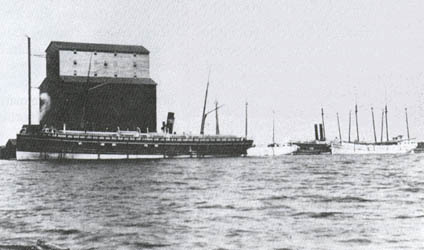Vol. 17 No. 6
June, 1987
|
Stay Safe in 87
|
|

Moving Wheat
Still
Crucial
to Economy
|

Dave Jones
Corporate
Archives
|

One of the railway's three lake steamers at the
320,000-bushel grain elevator at Port Arthur, Ontario (now Thunder
Bay).
Moving wheat is so important to the Canadian economy
that everyone gets involved. Farmers, trucking companies, wheat pools, federal and provincial governments, and of
course the railways are all part of a network which is mostly taken for granted.
However, during the early years of its existence, the Canadian Pacific Railway had to shoulder much of the
responsibility for getting the crop to the marketplace.
At stake was the welfare of the struggling farmer, the prosperity of the fledgling railway, and the reputation of
the Canadian Northwest as a major player in the world food market.
While thousands of boxcars were required to move the wheat eastward, a system of grain warehouses and elevators for
storage at transfer points was equally essential.
To encourage private investors, the CPR offered a rebate of one-half of the tariff rate for moving
lumber to be used in the construction of elevators and mills.
Depending on prospective business, town sites were targeted for elevators of 10, 15, or 20,000 bushels minimum bin
capacity.
Any interested party wishing to erect an elevator on railway land could do so rent free for 20 years, provided that
they agreed to charge market rates for storage and not to discriminate between clients.
WAREHOUSE REPLACED
The construction of elevators, rather than warehouses, was encouraged as they were equipped with machinery for
cleaning the grain, and they had separate bins for storing different kinds and grades.
In warehouses, apart from the obvious disadvantage of not being able to clean the wheat, good crops were mixed with
bad, resulting in a market value only slightly above that of the lowest grade involved.
In areas where there were no elevators, however, warehouses were allowed as an interim measure, pending the eventual
increase in business that would justify the larger facility.
The railway's bridge and building gangs were also pressed into service when, in 1883, a temporary warehouse was
constructed at Port Arthur to handle the flow of wheat over the completed line from Winnipeg, while and elevator of
320,000 bushels capacity was being built.
Steam barges were contracted to move the grain from the Lakehead, as the railway line was not yet completed along
the north shore of Lake Superior. the "Erin" was the first boat to pull away from the docks, carrying a
full cargo in its hold which was partly bagged and partly loaded by wheelbarrow.
The following year the elevator at Port Arthur was opened for business and it could handle the unloading of nine
boxcars at a time.
More important yet, the company's three new Clyde-built lake steamships, "Algoma",
"Athabaska", and "Alberta", were placed in operation between Port Arthur and Owen Sound,
significantly improving the company's ability to move large quantities of grain.
The first wheat to be shipped overseas by the all-Canadian route was moved that year. Transported to
Port Arthur by rail, and onto the Atlantic seaboard by water and rail, it was loaded onto an ocean steamship bound
for Glasgow, Scotland.
By the end of the 1884 season, a large new elevator of 1,200,000 bushels capacity had been completed and placed in
operation at Fort William, Port Arthur's twin city. Situated on the Kaministiquia River, little grain moved through
this elevator at first, as a considerable amount of dredging was required at the river mouth to accommodate the
CPR's 85,000-ton steamers.
In the spring of 1885, the schooner "Slige" took the first load of 17,000 bushels from the new elevator,
followed shortly by a full load onboard the "Alogoma".
That season alone, Canadian Pacific's contribution to the movement of wheat over the Great Lakes topped 1,500,000
bushels. And the numbers continued to grow over the proceeding years.
Of course the real measure of the value of Canadian wheat depended on the reputation abroad of the flour produced.
Fortunately, baking tests conducted in Britain attested to the high quality of wheat from the Northwest, rivalling
that of anywhere in the world - perfect fodder for the propaganda machine back home.
This CP Rail News article is copyright
1987 by the Canadian Pacific Railway and is reprinted here with
their permission. All photographs, logos, and trademarks are the property of the Canadian Pacific Railway
Company.
|